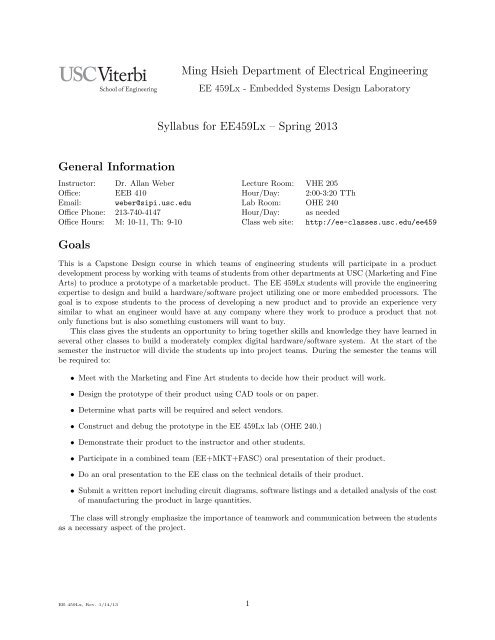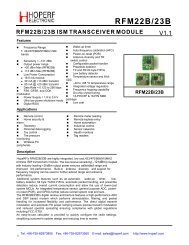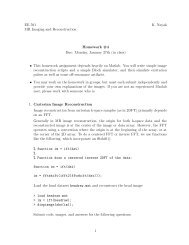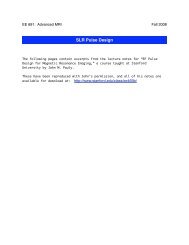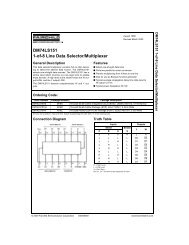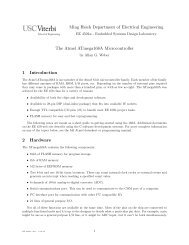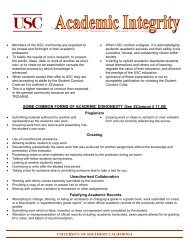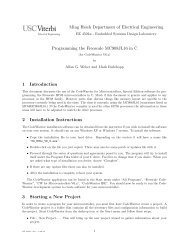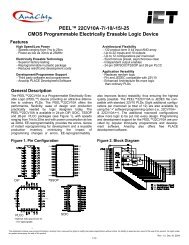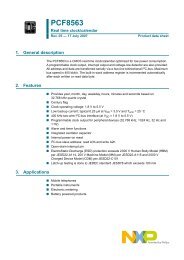Course syllabus
Course syllabus
Course syllabus
Create successful ePaper yourself
Turn your PDF publications into a flip-book with our unique Google optimized e-Paper software.
General Information<br />
Ming Hsieh Department of Electrical Engineering<br />
EE 459Lx - Embedded Systems Design Laboratory<br />
Syllabus for EE459Lx – Spring 2013<br />
Instructor: Dr. Allan Weber Lecture Room: VHE 205<br />
Office: EEB 410 Hour/Day: 2:00-3:20 TTh<br />
Email: weber@sipi.usc.edu Lab Room: OHE 240<br />
Office Phone: 213-740-4147 Hour/Day: as needed<br />
Office Hours: M: 10-11, Th: 9-10 Class web site: http://ee-classes.usc.edu/ee459<br />
Goals<br />
This is a Capstone Design course in which teams of engineering students will participate in a product<br />
development process by working with teams of students from other departments at USC (Marketing and Fine<br />
Arts) to produce a prototype of a marketable product. The EE 459Lx students will provide the engineering<br />
expertise to design and build a hardware/software project utilizing one or more embedded processors. The<br />
goal is to expose students to the process of developing a new product and to provide an experience very<br />
similar to what an engineer would have at any company where they work to produce a product that not<br />
only functions but is also something customers will want to buy.<br />
This class gives the students an opportunity to bring together skills and knowledge they have learned in<br />
several other classes to build a moderately complex digital hardware/software system. At the start of the<br />
semester the instructor will divide the students up into project teams. During the semester the teams will<br />
be required to:<br />
• Meet with the Marketing and Fine Art students to decide how their product will work.<br />
• Design the prototype of their product using CAD tools or on paper.<br />
• Determine what parts will be required and select vendors.<br />
• Construct and debug the prototype in the EE 459Lx lab (OHE 240.)<br />
• Demonstrate their product to the instructor and other students.<br />
• Participate in a combined team (EE+MKT+FASC) oral presentation of their product.<br />
• Do an oral presentation to the EE class on the technical details of their product.<br />
• Submit a written report including circuit diagrams, software listings and a detailed analysis of the cost<br />
of manufacturing the product in large quantities.<br />
The class will strongly emphasize the importance of teamwork and communication between the students<br />
as a necessary aspect of the project.<br />
EE 459Lx, Rev. 1/14/13 1
Interdisciplinary Product Development Teams<br />
The teams of EE 459Lx students will collaborate with teams of students from two other classes at USC:<br />
Marketing 446 (Practicum in New Product Development) and Fine Arts Sculpture 436 (Arts and Technology.)<br />
The MKT 446 student teams will perform market research and analysis to determine design requirements<br />
for a marketable product. The FASC 436 students will work on the physical design of the product and its<br />
packaging. The engineering, marketing and design teams will work together throughout the semester to<br />
produce a final product that not only operates as specified from a technical standpoint but also incorporates<br />
the features that make it a marketable product.<br />
Teamwork and communication, both within the engineering teams and between the parts of the interdisciplinary<br />
teams, is an important part of the product development process. The full teams will be required<br />
to meet each week to discuss their project and resolve any problems that have come up.<br />
Class Meetings<br />
For the first few weeks the class will meet during its scheduled time for lectures on project related topics.<br />
After that on most Thursdays the three classes (EE+MKT+FASC) will meet in HAR 112 and will break<br />
into product teams. This is your primary opportunity to discuss the product face-to-face with your MKT<br />
and FASC teammates.<br />
On Monday or Tuesday of most weeks each EE team is required to meet for about 30 to 40 minutes<br />
with the instructor to discuss their project. All members of the team are expected to attend the meetings.<br />
Bring all pertinent project documents (schematics, software listings, etc.) to the meeting. If possible also<br />
bring the project board to the meeting so you can show what has been accomplished and how it will all fit<br />
together. Be prepared to discuss what you are currently working on and what you plan to do over the next<br />
week. These meetings are your chance to ask the instructor questions about various aspects of the project.<br />
If you are confused about something in the project or are concerned that you might have misinterpreted<br />
something in the project specification, bring this up at the meetings. You should not use these meetings as<br />
the primary time for the team members to get together and communicate. The team members should be<br />
in communication with each other throughout the week and the weekly meetings with the instructor is to<br />
bring him up-to-date on your project.<br />
Grades<br />
Final course grades are based on the formula below.<br />
Detailed design review = 10%<br />
Weekly office meetings = 15%<br />
Project = 40% (a)<br />
Final project report = 15% (b)<br />
Interdisciplinary team evals = 10% (c)<br />
Instructor’s assessment = 10% (d)<br />
Total 100%<br />
Notes:<br />
(a) This assumes that all team members contribute about equally to the project. A team member who<br />
does not contribute as much to the project as the others will have their grade reduced accordingly.<br />
(b) Besides the technical aspects, your final report will be graded for its writing style, grammar,<br />
effectiveness and form. Examples of final project reports from previous semesters are available<br />
from the instructor.<br />
(c) MKT and FASC teams provide evaluations on how well the engineering teams worked with them.<br />
(d) The instructor’s assessment will include teamwork, communication skills, work habits, office and<br />
lecture attendance, methods used in accomplishing the project, and project scheduling.<br />
EE 459Lx, Rev. 1/14/13 2
Weekly Schedule<br />
The schedule below is subject to change. Check the class web site for updates. The following terms are used:<br />
“Class meeting” = All EE students meet in VHE 205.<br />
“Lab meeting” = All EE students meet in OHE 240.<br />
“Group meeting” = Everybody (EE+MKT+FASC) meet together for presentations.<br />
“Team meetings” = Everybody (EE+MKT+FASC) in the same room but broken into product teams.<br />
“Office meetings” = Each EE team meets separately with the instructor for 30-40 minutes.<br />
Week Tuesday Thursday<br />
1 Class meeting - Overview of the course, Class meeting - Everyone to introduce<br />
1/14-1/18 project requirements<br />
themselves. Discuss project topics<br />
2 Group meeting (HAR 112) - Intro to Team meetings (HAR 112) - Problem<br />
1/21-1/25 EE/MKT/FASC, project description identification, concept brainstorming<br />
3 Lab meeting - Hardware construction Team meetings (HAR 112) - Define<br />
1/28-2/1 techniques and lab tutorial, Lab #1 out rough concepts for 2D designs<br />
4 Lab meeting - Lab #1 due, Lab #2 out Team meetings (HAR 112) - Discuss 2D<br />
2/4-2/8<br />
designs, define concept names<br />
5 Class meeting - Ethics workshop Team meetings (HAR 112) - Concept<br />
2/11-2/15<br />
testing results, scoring model criteria<br />
6 Office meetings, Lab #2 due, Lab #3 out Team meetings (HAR 112) - Finalize<br />
2/18-2/22<br />
concept definition, review scoring model<br />
7 Office meetings, Lab #3 due, Lab #4 out Team meetings (HAR 112) - Review and<br />
2/25-3/1<br />
agree on product protocol<br />
8 Class meeting - DDR Presentations Class meeting - DDR Presentations<br />
3/4-3/8 Lab #4 due<br />
9 Team meetings (HAR 112) - Potential (Optional) Office meetings or trip to ICT<br />
3/11-3/15 concept revisions discussed and finalized<br />
10<br />
3/18-3/22<br />
Spring Break Spring Break<br />
11 Office meetings Team meetings (HAR 112) - Project sta-<br />
3/25-3/29<br />
tus review<br />
12<br />
4/1-4/5<br />
Office meetings<br />
13<br />
4/8-4/12<br />
Office meetings Prototypes (mostly) complete<br />
14 Office meetings (optional) Team meetings (HAR 112) - Final presen-<br />
4/15-4/19<br />
tation prep and roles<br />
15 Group meeting (EEB 248)<br />
Class meeting (Technical presentations)<br />
4/22-4/26 Team Oral Presentations<br />
16 Group meeting (EEB 248)<br />
Class meeting (Technical presentations)<br />
4/29-5/3 Team Oral Presentations<br />
<strong>Course</strong> evaluation<br />
The deadline for finishing the project is 4 PM on Friday, May 3rd. Teams must demonstrate<br />
their project (working or not) to the instructor by this time. The instructor will provide more information<br />
on the schedule for project demonstrations towards the end of the semester. Turn in the written final<br />
project reports to EEB 410 by 4 PM on Tuesday, May 14th. Return all items checked out (tools,<br />
lock, etc.) to EEB 410 by Wednesday, May 15th.<br />
Last day to withdraw from the course without a mark of “W” is February 1. Last day to withdraw from<br />
the course with a mark of “W” is April 12. An incomplete grade can only be assigned if there is a verifiable<br />
cause that is acceptable to the department and the University. Simply running out of time to complete the<br />
project is not grounds for being granted an incomplete.<br />
EE 459Lx, Rev. 1/14/13 3
Intellectual Property<br />
The nature of the projects in EE 459Lx makes it unlikely that any issues will come up related to the<br />
intellectual property rights of all or part of the project. However should such issues arise they will be<br />
resolved in a manner consistent with USC’s policies on these matters.<br />
Laboratory Facility<br />
The projects will be constructed in the Advanced Technology Lab (OHE 240.) Access to the lab is by USCard<br />
and students can work in the lab whenever they have time available including evenings and weekends. If<br />
necessary due to the size of the class, a reservation system will be used to allow team members to sign up<br />
to use the lab facilities at designated times.<br />
The lab has a set of lockers available for the students to store their project and tools. Each team will be<br />
assigned a locker and issued a lock. Teams can check out a set of tools for use in the lab during the semester.<br />
A $30 cash deposit must be left with Mr. Tim Boston in EEB 100 for the tools. The deposit for the tools<br />
will be returned at the end of the semester after returning the tools to the instructor.<br />
The EE 459Lx students are responsible for their activities in the lab. Do not invite friends to come and<br />
use the lab as a lounge or study room while you are there. All students should make an effort to keep the<br />
lab relatively neat and orderly. The tool you misplace today may be the one you will need next week. Notify<br />
the instructor if any lab equipment is not working or missing.<br />
Project Tasks<br />
Aside from the actual building of the project, all teams must also complete the following items.<br />
Lab Assignments<br />
A small number of lab assignments will be given during the first half of the semester. These are assigned at<br />
a point in the semester when the EE teams are waiting for their MKT teammates to do market research and<br />
before the product specifications are finalized. They will all involve adding some hardware to the project<br />
board and demonstrating that it works as required. The purpose of the lab assignments is to get teams<br />
familiar with the equipment in the lab and working on aspects of their project that they will eventually need<br />
to have completed. The lab assignments do not require turning in a report on the work. Just showing the<br />
instructor what you have done is sufficient.<br />
Detailed Design Review<br />
A detailed design review (DDR) is intended to go over all the necessary details of a project before it is<br />
implemented. You may start some hardware or software implementation before your DDR to verify certain<br />
aspects of your design (clocking, programming of the microcontroller, etc.) but no full-scale implementation<br />
work should be done until your DDR is completed. Any planned simulations may be done and would be<br />
helpful but are not strictly required.<br />
Your DDR should provide an overview of the project that describes what it is you are building, and<br />
a detailed description of each module in the project and definition of the interface between each module.<br />
For hardware modules, this should include detailed schematics down to the level of pin numbers of each<br />
IC. It should also include a description of tests that will be made to confirm the proper operation of the<br />
hardware module. For software modules, your detailed design should define all major functions and include<br />
a high-level, algorithmic description of each. Software tests should also be defined that demonstrate the<br />
proper functioning of the software module. For example, input and output functions can be tested by having<br />
the outputs change according to different input conditions. The DDR should also include a discussion of<br />
what system integration tasks will be done and how the system integration will be tested.<br />
EE 459Lx, Rev. 1/14/13 4
The DDR must include an estimate of the project’s cost. Based on your design, estimate how many<br />
IC’s you think will be needed and how many other components and from these numbers come up with an<br />
estimate of the cost of constructing the project. Do not include any overhead, labor or manufacturing costs.<br />
An important part of the review is a time-line schedule showing when each project task is to be completed:<br />
designing, simulating (if applicable), assembling and testing of each module, and integration of the modules.<br />
This timeline should include all the major tasks that the team will have to work on during the semester right<br />
through the writing of the final report. The timeline must be designed to allow completion of the different<br />
milestones on schedule.<br />
After the DDR, the teams should be ready to start full-scale construction of their project. All major<br />
design tasks should be completed and only require slight modifications from then on.<br />
Engineering Notebook<br />
All teams must provide a notebook for keeping together all documents pertaining to their design and bring<br />
the notebook to the weekly meetings. Showing up at weekly meetings with a loose stack of random papers<br />
containing your design is not acceptable. Your notebook should contain the following:<br />
• Schematic diagram of the project (must be up-to-date)<br />
• Software listings of your programs (must be up-to-date)<br />
• Datasheets of IC used in your project<br />
• Notes made by the team members about the project<br />
• Extra blank paper<br />
Maintaining a current and clearly drawn schematic is very important. It is nearly impossible for the<br />
instructor to help you design and debug your project if there is nothing for them to look at.<br />
One guideline to use for the notebook is to assume you may go to work in the lab one day and find that<br />
none of the computers in the lab have Internet access. Since you can’t get to the class web site (or anywhere<br />
else) for information, you need to have all the information in the notebook.<br />
Final Report<br />
The project final report should include everything about the project: schematics, timing diagrams, software<br />
listings, block diagrams, pictures, etc. Most importantly it should include a detailed description of how it<br />
works. It should state what the project does and how it does it in sufficient detail that any electrical engineer<br />
can read the report and understand exactly how it works. It is not a journal of your semester in the lab<br />
(“. . . and then we wired up this IC . . . ”) However it can include information on any interesting discoveries<br />
you made about the project and it’s components that you think people should know about. It should also<br />
include any conclusions you have reached about how the project could be improved upon if you had the time<br />
to implement these changes.<br />
Cost Analysis<br />
The final report must contain a detailed cost analysis of the project. The idea here is to find out how much<br />
it would cost to produce a product based on your design, probably in large quantities. Whoever ends up<br />
building the product needs to know how much of everything they need to purchase and how much it will<br />
likely cost. The cost of everything used in the construction of the project must be accounted for. This<br />
includes: all ICs, IC sockets (if they would be used in the final product), discrete components (resistors,<br />
capacitors, etc.), connectors, hardware (nuts, screws, etc.), wire, solder, etc. For items like wire and solder<br />
just estimate roughly how much was used. The cost of all the components can be found in catalogs like<br />
Jameco and Digikey that are available in the lab or on their web sites. Assume that the product will be<br />
manufactured in quantities of at least 1,000 units and use the unit costs that would be available when buying<br />
the parts in these quantities.<br />
EE 459Lx, Rev. 1/14/13 5


